Why T-34 lost to PzKpfw III, but won against Tigers and Panthers. Design refinement
Alas, this is (at least partially) a false statement. Unfortunately, story The machine tool industry of the USSR is not very well covered here, and it is extremely difficult to find the appropriate literature. The author of this article finally managed to get a very thorough work of Aizenstadt, LA and Chikhacheva S.A. under the title "Essays on the history of the machine tool industry of the USSR" (Mashgiz, 1957 g.). According to the data of Eisenstadt, LA and Chikhacheva S.A. the first single-rack turning and rotary machine with a faceplate diameter of 800 mm was released at the Sedin factory (Krasnodar) in 1935. Apparently, this is a 152 machine, although this, unfortunately, is not accurate - the authors of Essays, unfortunately did not specify the names of turning and rotary lathes, produced before the war. At the same time, as follows from a comparison of the “Essays” with the data on the plant’s history posted on its official website, despite the production of the first sample in 1935, the 152 machine was accepted by the state commission with a “useable” resolution only in 1937.
As for other models of turning-and-boring lathes, Essays report that 1940 machine models were also produced in 2: one-rack with 1 450 mm faceplate diameter and a two-rack with 2 000 mm face plate. Unfortunately, it is completely unclear whether it is about experimental production, or serial production.
Although this does not apply to the topic under discussion, it is interesting that at the plant. Sedin in 1941 g was completed the production of a giant turning and rotary lathe 520 t with a diameter of the faceplate 9 m - assembled this machine plant them. Sverdlov in Leningrad.
Returning to the tank theme, we note that two very important issues remain undisclosed. Firstly, unfortunately, the author was not able to find out whether serial production of turning-and-boring lathes with a faceplate diameter of 2 000 mm was set up before the start of the war and during it in the USSR, and if that was done, how many machine tools were produced in the prewar and war years. As you know, the plant them. Sedin was in the occupied territory in the period from August 9 1942 to February 12 1943, but before the retreat the Germans almost completely destroyed the plant. But what can it tell us? Some number of machines on it could have been done before the plant was “captured,” besides, the equipment needed for the production of machines could be removed during the evacuation, and then the production of turning-and-boring lathes could have been set up somewhere still. On the other hand, the author of this article did not find any mention of this. Here and Eisenstadt LA and Chikhachev S.A. about the military production of turning and turning machines do not say anything. But at the same time, respected authors write that during the Great Patriotic War, the machine tool industry of the USSR mastered the production of a large number of machine tools of new designs, cite many examples, but directly indicate that it is absolutely impossible to list them all at least in some detail. Maybe the issue of turning-and-boring lathes was beyond the scope of their work?
The second question is: unfortunately, it remains unknown whether it was possible to start production of tank shoulder straps on these machines, since many dear readers, as rightly noted in the comments to the previous article, the fact that the diameter of the face plate is larger than the diameter of the shoulder strap does not guarantee such a possibility.
The fact is that the diameter of the tank shoulder strap is one thing, but the dimensions of the part that you want to lay on the faceplate in order to process the tank shoulder strap is completely different. Nevertheless, the second question, apparently, can be answered in the affirmative, because it should not be considered that for the processing of a tank shoulder strap it was necessary to perch up an entire tower on a turning-and-boring lathe. After all, the tower epaulet was one of its details, and, as can be seen in the photo of those years, was processed separately from the tower. So, for example, on the earlier photograph of the turning-and-boring lathe.
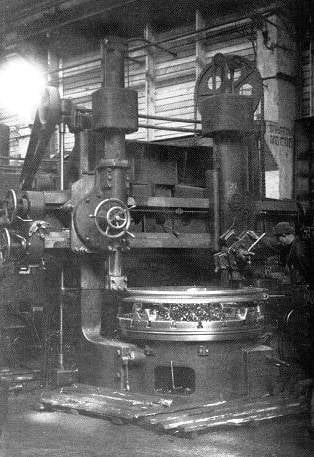
Just captured the procedure for processing tank shoulder strap for T-34 at the plant number 183 in 1942 g. Another photo.
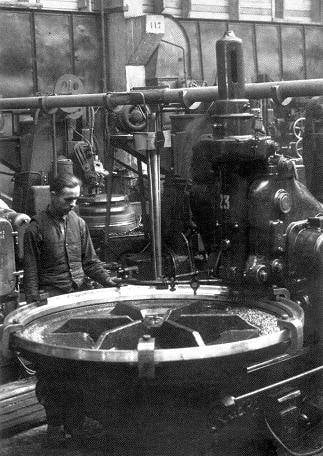
Demonstrates the procedure of cutting the turret's teeth at the same plant No. XXUMX in the same 183, but, of course, already on a machine of a different type. As we can see in both photos, the size of the machined parts is much smaller than the T-1942 tower and, perhaps, it is quite close to the diameter of the shoulder strap.
Accordingly, the question of whether turning-and-boring mills suitable for machining wide shoulder straps of T-34М and T-34-85 towers were produced before the war in the USSR remain controversial. But the fact that even before the beginning of World War II our factories had a large fleet of such machines with a large faceplate diameter is beyond doubt, since the other considerations expressed by the author in the previous article remain valid. Of course, we needed machines for the production of locomotive wheels, excavators and other equipment, and, if they were not Soviet-made, then, obviously, we acquired them abroad. Recall also the letter of Lieutenant Colonel I.Panov, who reported in 1940 that Plant No. 183 has a sufficient machine park for the production of tanks with an expanded shoulder strap. Recall that the applications for 1941 for the purchase of imported equipment of the plants No. 183 and 75, as well as the FCZ did not contain turning-and-boring lathes. And this despite the fact that Plant No. 183 was supposed to start producing T-34М with a wide shoulder strap in 1941, and STZ was required to be ready to launch T-34 into the series starting on 1 in January of 1942. Recall that T-34-85 started at our plants before lend-lease machines were supposed to do, etc. And, of course, for the production of 250 tanks IS-2 per month, plant No. 200 needed 7 of turning-and-boring lathes with a large face plate diameter, and how many were needed for plant No. XXUMX, which produced T-183-750 per month to 34? Could his needs be met by several machines that we received through lend-lease?
And if you still remember that, to date, no one has presented to the general public data on the volumes of supplies of turning and rotary machines for Lend-Lease, it turns out quite interesting. We know that the USSR was going to order such machines abroad for the 1944 production program, but we don’t know if they were ordered, and if so, whether they were delivered, when and in what quantity. Similarly, it is not known whether such machines were supplied under Lend-Lease earlier, or through other channels: During the war years, the USSR purchased products that were not included in the lists of allowed under Lend-Lease, that is, as part of the usual sales transactions.
Finish the topic with turning-boring machines and move on to the features of the production of T-34 in 1941-42.
So, as we said earlier, at the time of putting into production, the T-34 project contained a number of flaws, the main ones to be considered as insufficient crew size, poor visibility from the tank and significant transmission deficiencies. In addition, the tank suffered a fair amount of "childhood diseases" that could be quite easily eliminated by the results of trial operation. And, as if this was not enough, the plants where it was planned to expand the production of T-34, previously did not produce medium tanks, as the light tanks were made at the plant number XXUMX, and no tanks were produced at the STZ in general before.
The disadvantages of the T-34 were well recognized by our management, however, it was decided to send the tank into mass production. For such a solution, 2 root causes are reviewed. The first of these was that even in its current form, the T-34 was clearly superior to the light tanks BT-7 in its fighting qualities, not to mention any T-26 and so on. The second is that it was impossible to organize the production of such a new and complex machine, which was the T-34, for plants No. XXUMX and STZ in a single moment, it was necessary to build an efficient production chain within the enterprises and no less effective interaction with counterparties-suppliers.
And so it was decided to produce the T-34 in its current form, but at the same time to develop an improved, modernized design of the tank, which would be free from the known design flaws. The design of this tank is known as the T-34M - here both the commander's turret, and five crew members, and a tower with a wide shoulder strap, and a new transmission ... At the same time, the T-34М was to go into mass production as early as 1941 and, gradually, push out T-34 sample 1940 g.
Obviously, such a solution made it possible to kill not even two, but several birds with one stone. On the one hand, medium tanks with an 76,2-mm cannon and anti-missile booking immediately began to enter the Red Army. The troops began to master a new, unfamiliar technique. Plants - to work out the production processes and the effectiveness of the chains of their suppliers. The price for this was that the T-34 was delivered to the troops with already known, but not eliminated, flaws. Of course, it would be possible to take a different path and postpone the release of the T-34 until all its flaws are resolved, but, apparently, the leadership of the Red Army rightly believed that it was better to have an imperfect tank in the army than not to have a good . And besides, as soon as the T-34М project and its aggregates are ready, the domestic industry would be as ready as possible for its mass production.
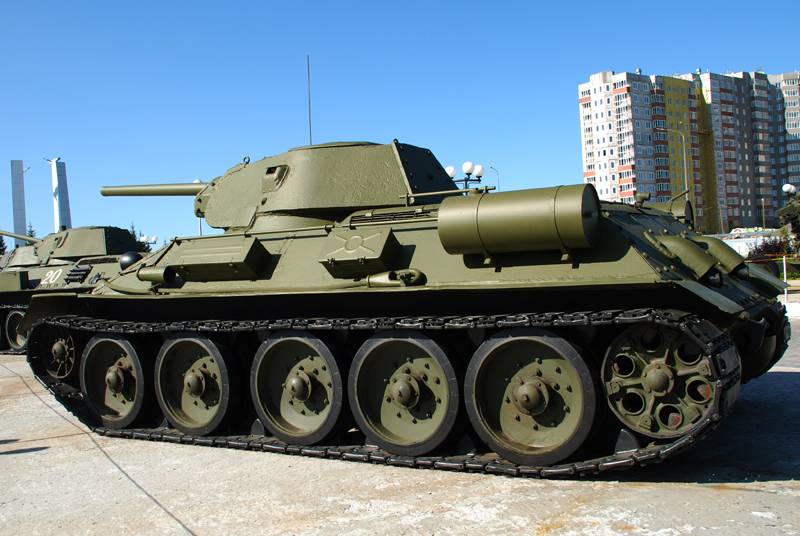
Thus, we see that the production of “raw” still T-34 before the war has quite reasonable explanations. But then another question arises. With the approach described above, the rejection of some serious modernization of the T-34 arr. 1940 G. - it did not make sense, since as early as 1941 it had to go to the T-34M series. But the war began, the new diesel engine for the T-34M was never ready, and it became clear that no Thirty-Fours-em would go to the troops. Then why the first changes for the better are the new checkpoint, the commander's cupola, etc. appeared on serial T-34 only in 1943? What prevented to do it before?
Very often in the descriptions of T-34, the simplicity of the tank design is noted, thanks to which it was possible to adjust its mass production in the belligerent USSR. This is certainly correct, but it should be noted that this “thirty-four” virtue was not at all gained right away. Of course, the creators of the tank, M.I. Koshkin and A.A. Morozov, put a lot of effort in order to achieve an outstanding result, without resorting to complex technical solutions. But nevertheless the T-34 design as of 1940 was very difficult for our factories where it was supposed to be manufactured, especially in wartime. So, for example, “History of tank building at the Ural tank plant No. XXUMX them. Stalin "indicates that" The design of the armor details ... was carried out without taking into account technological capabilities, as a result of which such parts were designed ... whose production in series production would be impossible ... ". At the same time, unfortunately, initially "... the production technology was designed for the presence of skilled workers who can produce complex mechanical parts of the tank using universal equipment in small batches, and the quality of processing depended on the worker's qualifications."
Simply put, the designers created a promising tank project, but it soon became clear that its design was far from optimal for production on the equipment available at plant No. XXUMX, or it required highly qualified personnel that the enterprise lacked or did not have at all. In some other processes, the plant could have enough equipment and qualified personnel, but for relatively small volumes of mass production, and the tank was supposed to be truly massive. Accordingly, it was necessary to find a compromise - somewhere to change the design of the machine or its individual parts, and somewhere - to purchase and install new machines, change the production technology.
This is easy to talk about when it comes to one enterprise, but in some cases such design changes concerned not only the plant where the final assembly of tanks is carried out, but also its subcontractors. And now we also recall that the T-34 manufacturing plant was far from being one, and, naturally, the machine park and the skills of the workers for them differed significantly.
“What did you think about before the war?” The dear reader will ask, and, of course, he will be right. But let us remember that the production volumes for 1941 were not at all amazing: 1 800 tanks for plant No.183 and 1 000 tanks for STZ. These are only 150 and 84 machines average monthly. Under this production program, the management of enterprises determined the need for an additional machine park, frames, etc. At the same time, with the beginning of the war, it was necessary to increase production volumes by several times, which, obviously, the machine park and the personnel structure of the FCZ and Plant No. XXUMX were not fully calculated.
And we are talking only about those plants where it was planned to produce T-34 before the war, and, accordingly, various preparatory activities were carried out. But let's not forget that during the 1941-42 years. T-34 production was mastered at 4 plants: №№112; 174, as well as UZTM and CHKZ.
Before the war, the leader in T-34 production was definitely Plant No. 183, for example, for the first 6 months of 1941, 836 tanks were produced on it, while on STZ, only 294. In June, 1941 Plant No. 183 released 209 machines, and STZ only 93. But the plant №183 was located in Ukraine, in Kharkov, and, of course, it urgently needed to be evacuated (to Nizhny Tagil), which was done in the period September - October 1941. It is clear that such a "relocation", and even such a short time would be extremely difficult, even in peacetime, but in the military it was a real labor feat. And, with all this in mind, it was necessary to somehow manage to increase production volumes in December ... In December 1941 Plant No. 183 produced all 25 tanks, in March 1942 - already 225, surpassing any monthly release of pre-war time , and in April - 380 machines, which by 42,8% exceeded the best release in Kharkov (266 tanks in August 1941).
As for the FCZ, it, unlike the Kharkov plant, did not relocate anywhere, but there were plenty of problems on it without evacuation. The front "rolled up" closer and closer, a significant part of the subcontractors stopped working, or no longer had the opportunity to supply parts and components on the FCZ. Thus, the plant had to master an increasing number of productions directly at home, and at the same time - to increase production rates ... what STZ did and did - the production of T-34 on it lasted until the battles started on the territory of the plant itself (and even a little Togo).
As for the rest of the plants, they were faced with no less a titanic task — they had to master the production of a completely new technology for them in wartime. Plant No.112 launched serial production in September of 1941, the other three plants mentioned above - in June - September of 1942.
So, it is absolutely obvious that in such conditions all efforts should be focused precisely on bringing the T-34 design to a level that would allow organizing its mass production, and not delaying this production by additional complication of its design. Therefore, starting at least since the winter of 1941 (and in fact - even earlier), the designers and technologists of plant No. 183 concentrated on working in the following areas:
1. The maximum possible reduction of parts of secondary importance in the tank, the exclusion of which should not reduce the technical and combat qualities of the machine.
2. Reduction of normal parts used on the tank, both in quantity and in frame sizes.
3. Reduction on the details of the places to be machined, with a simultaneous revision of the degree of purity of the processed parts.
4. The transition to the manufacture of parts by cold forming and casting instead of hot stamping and forging used.
5. Reduction of the nomenclature of parts requiring heat treatment, various types of anti-corrosion and decorative coatings or special surface treatment.
6. Reduction of components and parts obtained in the order of cooperation from the outside.
7. Reduction of the range of brands and profiles of materials used for the manufacture of the tank.
8. Translation of parts manufactured from scarce materials to manufacture from substitute materials.
9. Expansion, where it is allowed under the terms of the work, permissible deviations from the technical conditions.
So, in 1941 - 1942's. In these areas, amazing results have been achieved. As of January 1942, changes were made to the 770 part drawings, and 1 265 part names were completely abandoned. It seems to be a fantastic figure, but for 1942, we managed to exclude 34 4 details from the T-972 design!
But one simplification or the exception of details, of course, was not enough. Changed and technological processes. For example, by the end of 1941 g, it was possible to abandon the machining of the welded edges of the armor details. This led to the fact that the complexity of manufacturing one set has decreased from 280 to 62 machine-hours, the number of finishing jobs doubled, and the number of regular rolls doubled.
Of course, the simplification of technology was a double-edged sword. On the one hand, the production was simplified and cheapened, but on the other hand, unfortunately, the quality fell: for example, the refusal of machining made high demands on the quality of the weld of armor details, etc. However, domestic designers and technologists perfectly understood these interrelations, trying to compensate for the simplifications in the T-34 design with the latest technologies, such as the introduction of automatic welding, which was tested before the war, but was massively introduced during the fighting. Or, for example, such as rolled dimensional strips equal in width to finished parts. Often, the use of such technologies not only compensated for the simplification of the design, but also in itself brought considerable savings. For example, automatic welding significantly reduced the requirements for the qualifications of workers and their labor costs, and rolled dimensional strips reduced labor costs for parts obtained from them by 36%, reduced the consumption of armored steel by 15%, and also reduced the consumption of compressed air by 15 thousand cubic meters. m. on 1 000 packages. Of course, by drastically simplifying the design and technology of the thirty-four, it was possible to drastically reduce its cost, for example, the T-34-76 production of the plant # XXUMX cost:
1939 year of release - 596 373 rub .;
1940 year of release - 429 256 rub .;
1941 year of release - 249 256 rub .;
And finally, 1942 year of release - 165 810 rub.
Alas, in all likelihood, it was not always possible to combine simplifications and compensating technologies in time, and it should be assumed that individual batches of T-34, released during that period, could be much more vulnerable than “standard” tanks arr. 1940, produced before any simplifications.
Of course, in 1941-42. The USSR managed to solve the problem of explosive growth in the production of T-34. In the 1941 g T-34, 3 016 machines were produced, in 1942 g - 12 535 machines. The maximum monthly production of this type of tanks in 1941 was reached in May and was 421 machine / month. And in 1942, the minimum output per month was higher and amounted to 464 tank (in January). In December, 1942 was able to bring it to 1 568 machines already!
At the same time, historians rightly say that it is extremely difficult to somehow distribute this stream among tank modifications. Here the Germans everything was simple - a tank of some kind of design is being produced, and let it be to myself. Then they figured out how to improve it, introduced changes - they added a small letter to the name of the tank, and that's a modification. They invented new improvements - they marked the improved car with the next letter, etc. In the USSR, with the T-34 was not the case. The fact is that the constant changes in the design and technology, as well as the adaptation of the tank design to the capabilities of each particular plant led to the fact that T-34 of the same production time, but different plants or different batches of the same plant were often not identical machines. . Much depended on the technologies that a particular plant has mastered, so, in 1942, the T-34 plant No. XXUMX cost, as mentioned above, 183 165 rubles, but T-810, produced at the “neighboring” UZTM (Chelyabinsk) - 34 273 rub.
In other words, about the thirty-three 1941-42. It’s possible to speak of the release not as a single T-34 tank of various modifications, but about the whole family of tanks, about the same performance characteristics, but with significant differences in design, constantly adapted to the equally constantly changing manufacturing technology at different plants.
Was it possible to introduce any changes into the design of the T-34 tank? Probably, it is possible, but such changes would necessarily cause a decrease in output - it would take time to master them. Could we afford to reduce the production of T-34? Recall that in 1942 we produced (without SAU) 24 448 tanks, including:
KV of all modifications - 2 553 pcs. (10,4% of total release);
T-34-76 - 12 535 (51,3%);
T-60 - 4 477 (18,3%);
T-70 - 4 883 (20%).
As you know, even before the start of the Great Patriotic War, the leadership of the Red Army and the country was well aware that tanks with anti-bullet armor were absolutely outdated, and if they were suitable for something else, then only to perform some auxiliary functions. However, in 1942 g 38,3,% of all tanks produced were light T-60 and T-70 with their 15-mm sides, two-man crew and 20-mm and 45-mm guns, respectively.
Such a stream is explained very simply - the Red Army absolutely lacked tanks, and any, even the poorest, tank is much better than its absence. But as a result, our army was forced to use T-60 and T-70 as, if one may say so, the main battle tanks, although of course such a concept did not exist in those years. Of course, the results of the fact that at that time the entire range of tasks confronting the tank forces of those times was forced to be assigned to extremely light losses for the armored vehicles themselves and its crews.
Was it possible at this time to reduce the release of the T-34, which at that time (1941-42) still retained the title of a tank with a counter-booking?
Often in the comments to this or that publication one has to read that, they say, the mass production of non-modernized T-34, moreover, and often not of the best quality, “excellent” characterizes the cannibal nature of the then USSR leadership and, of course, personally of Comrade Stalin. But if the production workers had attended to the new checkpoint and commander's turret in time, the losses in the T-34 crews would have been much less than it actually happened.
Of course, the loss among the tankers would then be less. But the tanks in the army would be less. And who will be able to count how many arrows, machine-gunners, artillerymen and other warriors would additionally have fallen into the land without the support of tanks as a result of reducing their output from what was actually achieved?
The arithmetic is, in fact, dreadful. And hard-to-predict even now, for us, people, in the fullness of the after-knowledge, analyzing the events of those bloody days. And to decide what is right and what is not, in those years ... Perhaps, of course, the management did not quite optimally. Perhaps, the introduction of the same commanding turrets would not so much slow down the release, who knows? Here we need to analyze the changes in labor intensity, as well as the capabilities of the machine park of each plant ... all this is far beyond the knowledge of the author of this article. But there is no doubt about one thing - a bet on the all-out expansion of the production of T-34, which was made in the most difficult conditions of 1941-42. and only then, after the 5 manufacturing plants reached their design capacity, does the T-34 upgrade look like a reasonable alternative to any other solution that could then be made.
To be continued ...
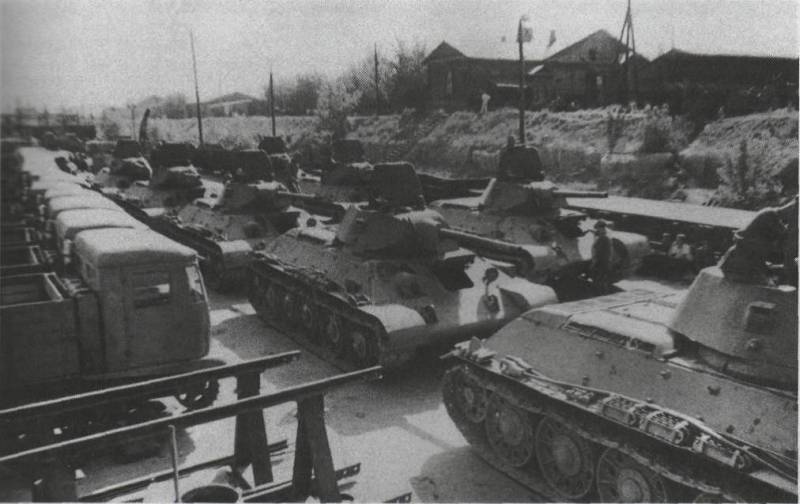
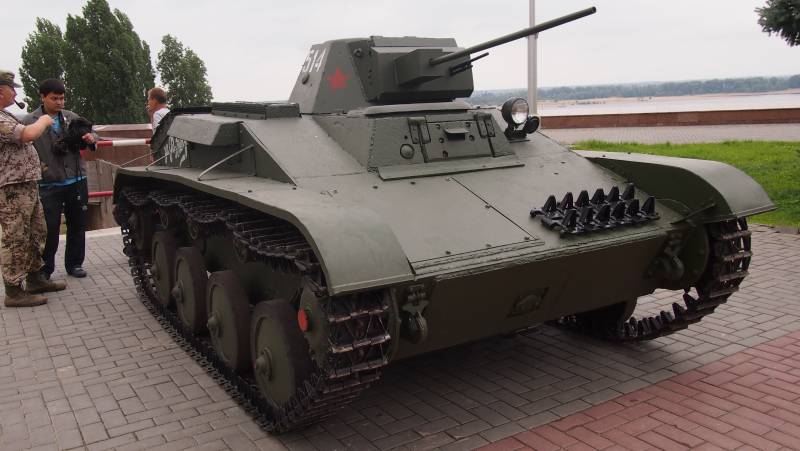
Information